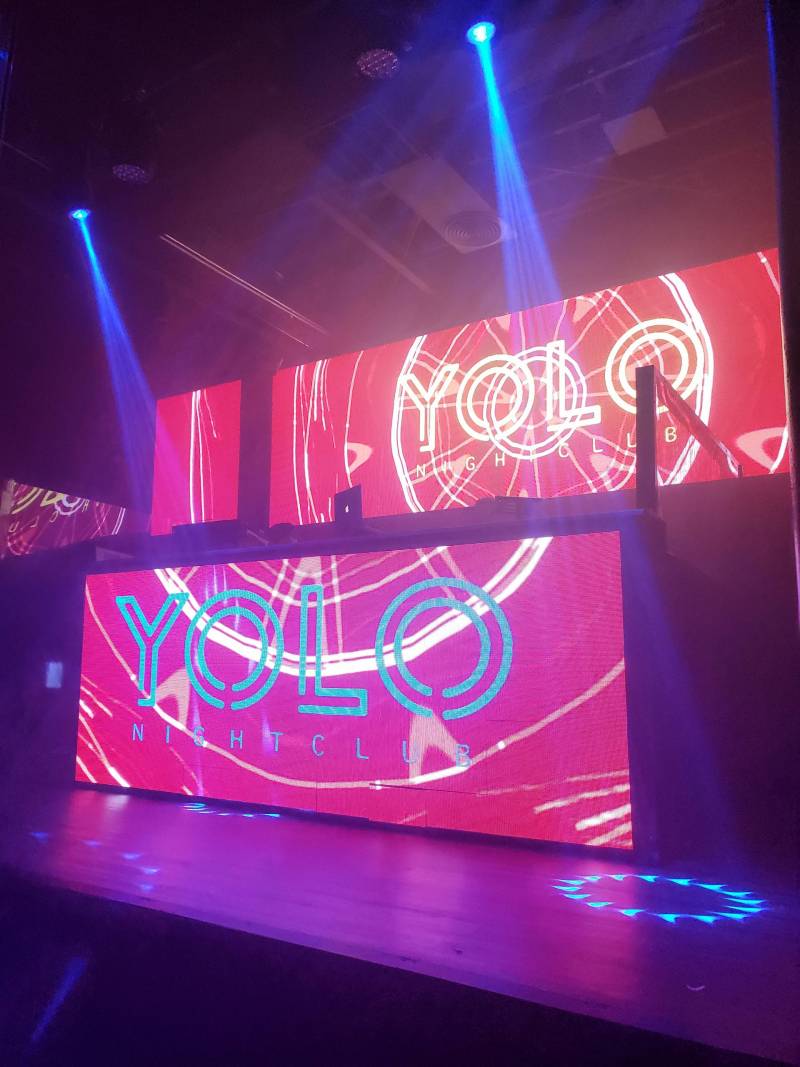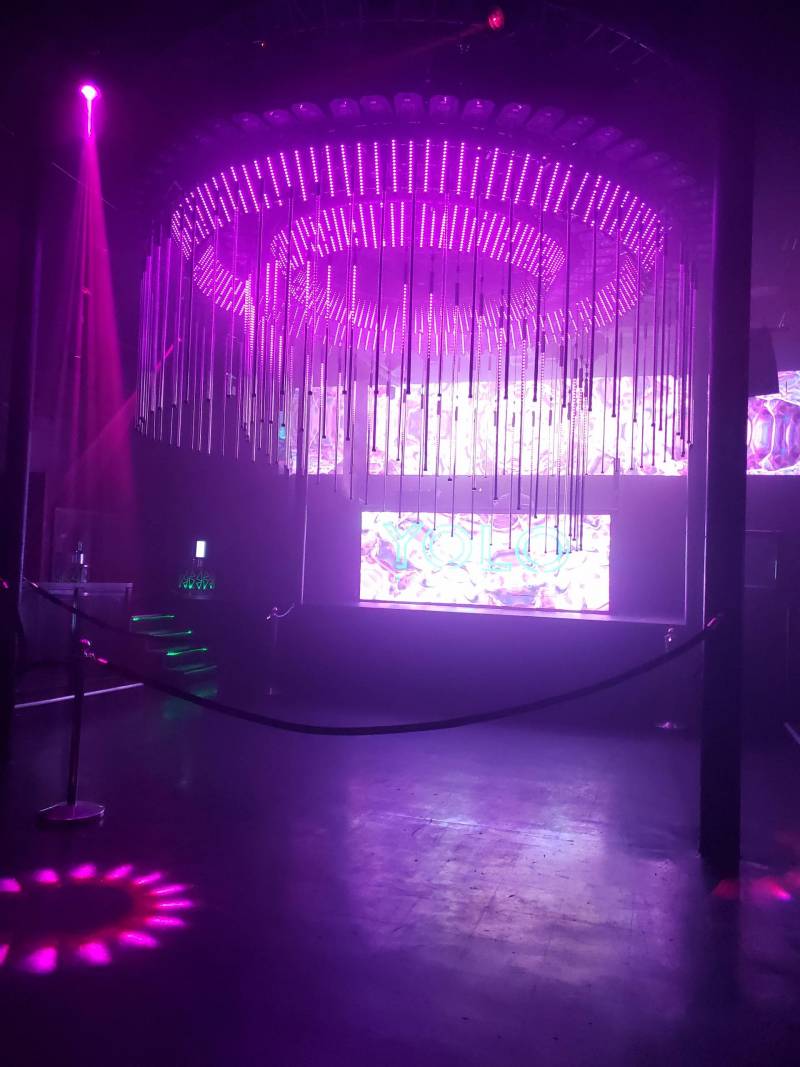Though it opened just this past weekend, people have been upset about new San Francisco nightclub YOLO for months now. (Broke Ass Stuart referred to the club as a “douchefest” all the way back in August 2020.)
I Went to YOLO—the Nightclub That Replaced Slim's—So You Don't Have To

For live music fans, the reality of YOLO’s opening was reason enough to be upset. Slim’s, a live music institution in the city for over 30 years, was being replaced by a dance club featuring DJs only. Then, it was discovered that the new owners were Peter Lin and Michael Hu, who own Sunnyvale’s Pure Nightclub. And Pure is the kind of place where “sports, recreation [and] athletic attire” are prohibited for club-goers, but female waitresses are required to wear lingerie.
More recently, adding insult to injury was YOLO’s social media. It didn’t start out great: a series of images focused mostly on objectifying women—disembodied legs in stockings, faceless bunny girls, faceless space girls, faceless side boob. But then the club ramped things up with a motivational meme that told people to “Speak English” and “Spend Arab.” (One KQED Arts reader was alarmed enough to take a screenshot and send it to us.)

With all this in mind, I was fairly stunned on Friday night to drive past 333 11th Street at 10:45pm and see pandemonium outside the club. It was a lot, even for the first weekend after California’s lifting of COVID restrictions. There was a throng under the awning, and roped-off lines to both the left and right of the front door. People weren’t just casually trying out YOLO, I realized—they were willing to stand in very long lines to get in.
In a fit of masochistic madness, and after seeing a sea of YOLO hate on my Facebook feed, I decided to go the following night. I did so knowing full well that I’d have to go it alone (no one I know would agree to step foot in there), and that the experience might be a little emotionally wrenching. Slim’s wasn’t just a place where I saw a lot of great shows; it was a place where I had in fact worked for a couple of years, over a decade ago.
Because of my general aversion to standing in lines, I got to YOLO two minutes after it opened. To the right of the door was the line for VIPs—people who had paid in advance for tables. I joined the line on the left for RSVPs and guest list. (All future events at YOLO will be ticketed; July 9 tickets to see Jersey Shore‘s Pauly D, for example, will cost you $35-45, plus booking fee.)
It only took me a few minutes to get inside. Once in, I was immediately greeted by the sight of multiple female employees dressed in bras, high-waisted underwear and stockings, and the sound of Justin Bieber’s “Sorry.” I had been expecting EDM, but the music for the rest of the night was decidedly and surprisingly… well… basic.

As for the decor, the Slim’s bar that once took up most of the far wall has been ripped out and replaced by two rows of plush blue seats. That fenced-in area is where groups of up to eight people can now pay $800 for the privilege of sitting. (Woo?) These tables are guarded by the women in lingerie who move bottles from the bar to the tables, and occasionally hold up props. At one point, I witnessed them waving a “Happy Birthday” placard and a white UV seagull on a stick, the symbolism of which escaped me entirely.
I managed to sneak a look at a drinks menu from a VIP table and it was fairly jaw-dropping. $1,400 for a magnum of Don Julio 1942 tequila; $900 for a bottle of Dom Pérignon Rosé; $675 for a handle of Grey Goose; and—my personal favorite—$375 for a bottle of Jameson that costs $24.99 in Trader Joe’s. Also, curiously, at the bottom of the UV-lit menu are three options for something called the “Bottle Parade Packages (With Presentation).” These range from $5,500-$6,000. I did not witness one of these presentations during my time at YOLO, but I can only assume they involve more UV animals on sticks.

A much smaller version of the old bar still stands at the back of the room under what used to be the Slim’s dinner balcony, which now houses the more “exclusive” VIP tables. I can only suspect that the bar has been reduced to this minimal size to cause long lines, further incentivizing patrons to throw down for table service. For those willing to wait, though, prices at the bar were reasonable by club standards. I paid $11 for a vodka soda, and it was a heavy pour served by a very efficient bartender.
At the front of the club, the Slim’s stage is now dominated by a DJ booth with garish projections both in front of and behind the DJ. These screens never stop telling you where you are, lest you forget how embarrassing the name of this club is. More bizarrely, in front of the stage, taking up a deeply impractical amount of space, is an undulating light fixture. It is roped off and inaccessible, and prevents nightclub patrons from getting within 20 feet of the DJ booth. It also takes out an enormous amount of the club’s floor space. Of all of the endless barriers installed in YOLO, the disco jellyfish is by far the most elaborate and stupid.

The door to the right of the stage, where bands used to load in, now leads to the smoking area, which comes with its very own security guard. (He was talking about Lamborghinis with another employee when I got there.) To the left of the stage, down the stairs, is the only part of YOLO that still bears a real resemblance to Slim’s. The coatcheck room is still there, but (practicality be damned!) was closed. And the bathrooms look exactly the same, even down to the leaky toilets in the ladies room. (The upstairs bathrooms were—alas—also roped off.)
Even more unfathomable than the closed coatcheck is the fact that no one bothered to throw down a couple of hundred bucks to paint the basement walls. The remaining grubby pattern of vertical rectangles is a sad reminder that these halls used to be lined with decades of show posters.

One thing that I will say for YOLO is that its staff was, across the board, remarkably warm and friendly—even the be-suited security guys. I took some consolation in that after an evening spent thinking about Section 3303 of the San Francisco police code. You know—that thing where you’re legally prohibited from hiring and firing people based on their weight. (Look it up, YOLO.)
The thing that I was most surprised about, however, were the patrons. These clubbers weren’t the obnoxious, over-privileged d-bags I had been expecting. They were regular people, mostly in their early-to-mid-twenties, wearing smart-casual shirts and camisoles. They were, in the majority, grown men and women dancing in gender-separated circles, like it was a school dance. I watched one group of twenty-somethings on that top balcony, staring longingly at the dance floor, seemingly having the realization that they’d paid a ton of money to not dance or meet anyone new. I was left with the distinct impression that all of these people were forking over too much of their hard-earned cash for, I presume, aspirational reasons.

On my way home from the club, my mother—who lives in a timezone eight hours ahead—happened to call me. I told her about YOLO in some depth and sent her some photos. “To each their own,” she said. “But gosh, vanity is expensive.”

